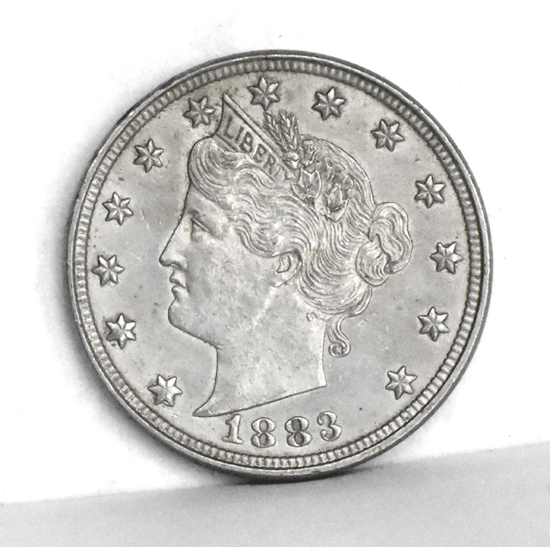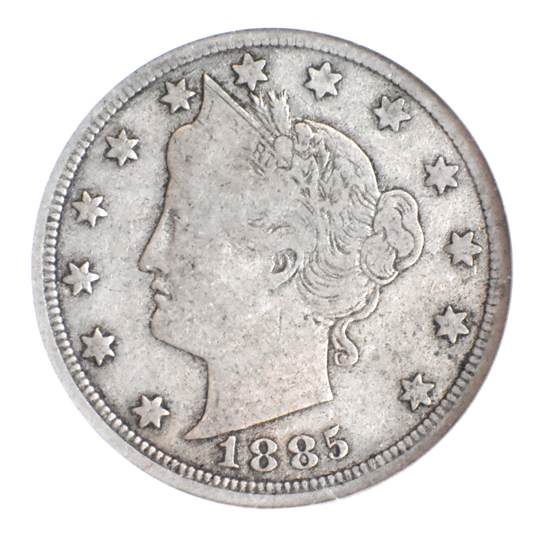Liberty Head Nickel
1883 No Cents
1883 to 1912 Cents
 |
In 1883 the Nickel was re-designed. Since the silver half dime was now no longer being minted, a portrait of liberty was restored to the obverse of this coin but the new designer, Charles E. Barber, trimmed the figure to a bust, an image which was to appear subsequently on other coins as well. The reverse of the new nickel originally displayed a large Roman numeral V without the word cents. This led to an embarrassing problem; unscrupulous individuals began gilding the coin with gold wash and passing them off as $5 gold pieces. This was corrected part way through the 1883 production year. With this exception, the design, sometimes called the Barber Nickel and sometimes called the Liberty Head Nickel, remained the same throughout its life, which lasted for 30 years.
The most valuable Liberty Head nickels are the 1885 and the 1912 S, except for the extremely rare 1913. |
 |
| This example cost me $40 and is uncirculated. I currently have a complete set of these nickels in the safe deposit box in the bank, except of course, the 1913, for which there are only 5 known specimens and each is worth millions. My set of these coins includes the 1885 (below) of which 1,472,700 were minted and the 1912 S for which only 238,000 issues were minted, but is valued less than the 1885. | This is the reverse of the coin at left. | |
 |
When the design was discontinued in favor of the Buffalo Nickel in 1913, the various mints throughout the country stated publicly that they never produced any of the previous issue with the 1913 date. However, it is known that at least 5 specimens exist and this coin is one of the rarest and most valuable of all U.S. coins in existence. Although this phenomenon is something of a mystery, it is widely believed that the new 1913 dies were manufactured before the decision to re-design the coin was made and then put aside, only to be found and used clandestinely by persons unknown for the purpose of producing a rare and valuable object for personal gain . |  |
| This is my 1885 example. It is slabbed and certified to be a VG 10, worth about $725 in the PCGS price list. I paid $665 for the coin some years ago. | This is the reverse of the coin at left. This photo shows the word 'CENTS' at the bottom. |
1883: January 19 – The first electric lighting system, built by Thomas Edison, employing overhead wires, begins service in Roselle, New Jersey. May 24: The Brooklyn Bridge is opened to traffic after 13 years of construction. May 30: In New York City, a rumor that the Brooklyn Bridge is going to collapse causes a stampede which crushes 12 people. Old west self-described "Black Bart, the Po-et" gets away with his last stagecoach robbery, but leaves an incriminating clue that eventually leads to his capture. November 18: U.S. and Canadian railroads institute 5 standard continental time zones, ending the confusion of thousands of local times. |
1885: February 16 – Charles Dow publishes the first edition of the Dow Jones Industrial Average. The index stands at a level of 62.76, and represents the dollar average of 14 stocks: 12 railroads and two leading American industries. February 18: Mark Twain publishes Adventures of Huckleberry Finn in the United States. September 2: The Rock Springs massacre occurs in Rock Springs, Wyoming; 150 white miners attack their Chinese coworkers, killing 28, wounding 15, and forcing several hundred more out of town. The first skyscraper (the Home Insurance Building) is built in Chicago, Illinois, USA (10 floors). December 1: The U.S. Patent Office acknowledges this date as the day Dr Pepper is served for the very first time; the exact date of Dr Pepper's invention is unknown. |